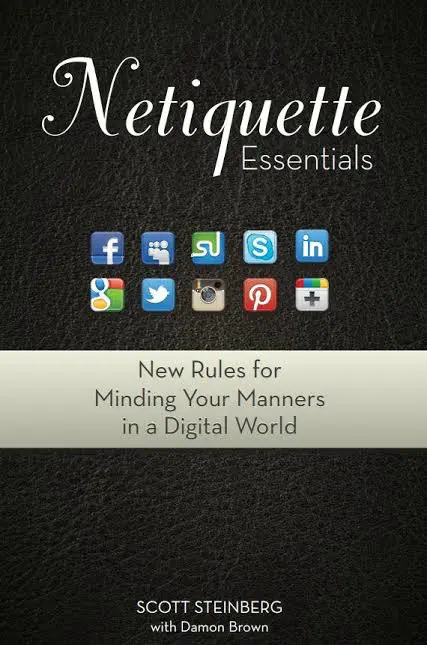Texting is becoming more and more popular especially amongst teens, tweens, and kids of all ages. But what are appropriate rules of conduct surrounding these text exchanges? Well, there are several best practices both adults and children should keep in mind while texting. We all need to make sure we’re minding their manners online. That is why I am happy to have Scott Steinberg, award-winning professional speaker and author of the book Netiquette Essentials: New Rules for Minding Your Manners in a Digital World to share with us some important texting etiquette rules.
Texting etiquette refers to the set of guidelines and manners one should follow when communicating via text messages. While texting is a convenient and quick way to communicate, observing proper etiquette helps maintain effective and respectful communication. In many cases, it’s a good idea to save complex discussions or the delivery of bad news for face-to-face meetings, where tone and context can be better understood. Here are some tips for texting etiquette.
THE TEXT COMMANDMENTS: 10 Rules For Text Message Etiquette
by Scott Steinberg
A little mindfulness and forethought are all it takes to enjoy more positive high-tech interactions. Here are ten tips for safer texting that can help you and your family put your best foot forward online.
Don’t text or talk while driving or in motion.
One of the most important texting etiquette rules is that at no time should you be so transfixed by a screen that you cannot safely navigate. Staring at a screen while walking isn’t just rude – it’s also potentially dangerous to yourself and others, and can result in unexpected stumbles, collisions or even serious injury. Texting or talking on your cell phone while driving may distract you, impair reaction times and endanger others, and should therefore always be avoided. While hands-free wireless Bluetooth headsets may mitigate some issues, the best solution is to pull over, park and finish conversations before resuming motion.
Save important exchanges for offline interactions.
Text messaging should be strictly casual by nature, and is inappropriate for weightier or more meaningful communications. For more important news or interactions (ending a relationship, sharing unfortunate events, etc.) a phone call or in-person exchange is more appropriate. Texting is excellent for quick confirmations, sharing brief information, or coordinating plans. However, complex discussions are better suited for other forms of communication.
Be conscious of how you communicate.
When abbreviating messages, show knowledge and respect of how the other party may interpret these communications – texts sent to your grandmother should look differently than texts sent to a teen, as each will comprehend and react to messages differently. It is important to note that slang, jargon, grammatical errors, and misspellings may save time and give messages a hint of character, but they may reflect poorly upon you or send the wrong message about your personal communication skills.
Make a proper introduction.
When texting people for the first time, or those who don’t have your name and number in their contacts listing or address books, be certain to introduce yourself and/or remind them of where you met. (“Hi, this is Scott, the netiquette guy. For our chat at 11AM about corporate training services, where would you like to connect?”)
Consider how messages may be interpreted.
As with emails or any form of written high-tech communication, tone or intention may be hard to convey through texting, and messages may be perceived incorrectly or taken out of context. Before sending, consider if the information is best conveyed with a phone call, short note or alternate form of communication.

Keep private information confidential.
Do not text private, embarrassing, intimate or confidential details. These messages aren’t just inappropriate to send- they are also all too easy to forward into the hands of unwanted parties. Double check names and numbers before texting as well, especially if making an important statement, lest you risk accidentally reaching out to the wrong party.
Refrain from sending inappropriate messages.
Another of the most important texting etiquette rules is to refrain from sending inappropriate messages. Sexting – the practice of sending sexually explicit material, including nude photos or lascivious references – is unacceptable and inappropriate under any circumstance. A major high-tech breach of conduct, it may also lead to embarrassment or prosecution.
Keep spam to a minimum.
Show courtesy for others’ time, patience and phone bill by switching from group texts to reaching out to individuals via direct texts when the conversation becomes irrelevant to others, and ask that they reciprocate.
Be short and sweet.
Texts should be kept brief – if you need to say more than can be fit into a few lines, write an email or pick up the phone instead. Be respectful of others and don’t carpet bomb them with texts – before sending, consider if they really need to receive your commentary in parts, or a smiley face separate from the main body of the message.
Don’t get snarky.
Should you accidentally receive a text intended for someone else, a simple “sorry, wrong number” will suffice to prevent further communication. Resist the temptation to be rude, snarky or annoyed when responding, and realize that ignoring the missive may result in subsequent attempts at communication.
I hope you found these important texting etiquette rules from Scott Steinberg helpful.
Text Response Time Etiquette
Another thing people often want to know about is text response time etiquette. This can vary widely based on the situation. Obviously, dating standards and business standards are different things and will have different acceptable text response times. Time sensitive requests should also be handled in a different manner from a funny meme you received. Then there is the age of the parties texting to consider.
Still wondering how long to wait before responding to a text? Here is the simple answer. Respond as soon as possible. It helps clear up any chance of miscommunication or frustration. According to Viber, “The fact is that 95% of texts will be read within 3 minutes of being sent, with the average response time for a text being a mere 90 seconds.” We can’t always be that fast but responding as soon as possible is the most polite option. If there has been a very long gap, you may want to mention you were away from your phone.
One of the most polite texting rules is to acknowledge receipt. If the message requires a response but you can’t reply immediately, acknowledge the message with a quick note, letting the sender know you’ll respond later.
Business Texting Guidelines
Text etiquette is essential in any professional setting, especially when using business texting as a form of communication. It’s important to remember that text conversations should remain respectful and appropriate for the workplace. Avoid sharing sensitive or confidential information via text, as this could pose a security risk. Team members should also be mindful of business hours and not expect an immediate response unless it’s urgent. Practicing respectful texting helps maintain clear and effective business communication and ensures that all interactions align with professional standards.
SMS communication and social media can be valuable tools when used appropriately, but it’s important to maintain a professional tone, especially in workplace settings. Whether you’re messaging in a group chat or sending personal texts, always double-check that you’re contacting the right person to avoid any confusion or accidental messages to the wrong person. A quick response can be helpful, but it’s also important to respect personal time and set boundaries for non-work hours. Using a professional greeting sets the tone for respectful conversation, and while it can be acceptable to use emojis in casual exchanges, they should be used thoughtfully in professional communication channels. When topics become complex or sensitive, consider switching to a face conversation to ensure clarity and understanding.
Text Etiquette Conclusion
Adhering to these texting etiquette guidelines helps ensure effective and respectful communication, minimizing misunderstandings and promoting positive interactions in both personal and professional settings. I hope you found these texting etiquette tips useful. Feel free to share them with your kids or coworkers. Is texting an essential form of communication for you?
Related Posts:



Priya says
Thank you for sharing with us for 10 Texting Etiquette Rules. I find that so many people need to read this!